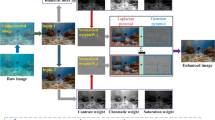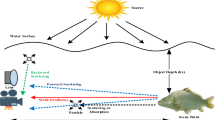Abstract
Underwater images/frames are always subjected to color distortion, contrast reduction and detail loss, which degrade the visual quality severely. Current dehazing methods could not improve the visual quality of underwater images/frames robustly and effectively, especially in removing the undesired color cast. To address the issue, this paper introduces an effective and robust underwater image enhancement method without any dedicated hardware or prior knowledge. First, an adaptive reduction operation on the two stronger color-channels of inputs is employed to avoid the red over-compensated deficiency appearing in color-balanced result. Second, three kinds of color-balanced images are generated from the operation, which combines color compensation algorithms and famous Gray-World assumption. Third, a novel algorithm based on two non-reference quantitative evaluation indicators is utilized to choose the optimal color-balancing version. Then, gamma adjustment operation is employed to generate artificial over−/under-exposure visions of color-balancing image. Last, ‘exposedness’ and ‘contrast’ are set as two weights, being blended into the famous multi-scale fusion framework to generate the enhanced result. Our experimental results demonstrate the superior performance of the proposed method in both subjective and objective evaluations. Besides, the proposed method is also suitable for dehazing regular fogged images and local feature points matching.










Similar content being viewed by others
Data availability
Datasets (UIEB, RUIE, and NH-HAZE) used for testing relevant underwater dehazing methods have been taken from following digital object identifiers: doi: https://doi.org/10.1109/TIP.2019.2955241, doi: https://doi.org/10.1109/TCSVT.2019.2963772, and doi: https://doi.org/10.1109/CVPRW50498.2020.00230. Diving scenes dataset used for testing relevant underwater image dehazing methods in this paper, is available from the corresponding author on reasonable request.
References
Alex Raj SM, Supriya MH (2016) Underwater image enhancement using single scale retinex on a reconfigurable hardware. International Symposium on Ocean Electronics, SYMPOL
Ancuti CO, Ancuti C, De Vleeschouwer C et al (2018) Color balance and fusion for underwater image enhancement. IEEE Trans Image Process 27(1):379–393
Ancuti CO, Ancuti C, Timofte R (2020) NH-HAZE: An image dehazing benchmark with non-homogeneous hazy and haze-free images. IEEE Computer Society Conference on Computer Vision and Pattern Recognition Workshops. pp. 1798-1805
Ancuti C, Ancuti CO, Haber T et al (n.d.) Enhancing underwater images and videos by fusion. Proceedings of the IEEE Computer Society Conference on Computer Vision and Pattern Recognition. pp. 81–88
Berman D, Levy D, Avidan S et al (2020) Underwater single image color restoration using haze-lines and a new quantitative dataset. IEEE transactions on pattern analysis and machine intelligence
Buchsbaum G (1980) Spatial processor model for object colour perception. J Franklin Institute 310(1):1–26
Burt PJ, Adelson EH (1983) LAPACIAN pyramid as a compact image code. IEEE Trans Commun COM-31(4):532–540
Chen W, Gu K, Lin W, Yuan F, Cheng E (2020) Statistical and structural information backed full-reference quality measure of compressed sonar images. IEEE Trans Circ Syst Vid Technol 30(2):334–348
Chen X, Yu J, Kong S, Wu Z, Wen L (2021) Joint anchor-feature refinement for real-time accurate object detection in images and videos. IEEE Trans Circ Syst Vid Technol 31(2):594–607
Drews-Jr P, Do Nascimento E, Moraes F et al. (n.d.) Transmission estimation in underwater single images. Proceedings of the IEEE International Conference on Computer Vision. pp. 825–830
Finlayson GD, Trezzi E (n.d.) Shades of gray and colour constancy. Final Program and Proceedings - IS and T/SID Color Imaging Conference. pp. 37–41
Fu X, Zhuang P, Huang Y et al. (2014) A retinex-based enhancing approach for single underwater image," 2014 IEEE international conference on image processing, ICIP. pp. 4572–4576.
Fu X, Zeng D, Huang Y, Liao Y, Ding X, Paisley J (2016) A fusion-based enhancing method for weakly illuminated images. Signal Process 129:82–96
Fu X, Fan Z, Ling M et al. (2018) Two-step approach for single underwater image enhancement," 2017 International Symposium on Intelligent Signal Processing and Communication Systems, ISPACS 2017 - Proceedings. pp. 789–794
Galdran A (2018) Image dehazing by artificial multiple-exposure image fusion. Signal Process 149:135–147
Hayat N, Imran M (2020) Detailed and enhanced multi-exposure image fusion using recursive filter. Multimed Tools Appl 79(33–34):25067–25088
He K, Sun J, Tang X (2011) Single image haze removal using dark channel prior. IEEE Trans Pattern Anal Mach Intell 33(12):2341–2353
Huynh-Thu Q, Ghanbari M (2008) Scope of validity of PSNR in image/video quality assessment. Electron Lett 44(13):800–801
Iqbal K, Odetayo M, James A et al. (n.d.) Enhancing the low quality images using unsupervised colour correction method. Conference Proceedings - IEEE International Conference on Systems, Man and Cybernetics. 1703-1709
Islam MJ, Luo PG, Sattar J (2020) [simultaneous enhancement and super-resolution of underwater imagery for improved visual perception] Mit press, Cambridge
Islam MJ, Xia Y, Sattar J (2020) Fast underwater image enhancement for improved visual perception. IEEE Robot Automa Lett 5(2):3227–3234
Li C, Quo J, Pang Y et al. (2016) Single underwater image restoration by blue-green channels dehazing and red channel correction. ICASSP, IEEE International Conference on Acoustics, Speech and Signal Processing - Proceedings. pp. 1731-1735
Li C-Y, Guo J-C, Cong R-M, Pang YW, Wang B (2016) Underwater image enhancement by Dehazing with minimum information loss and histogram distribution prior. IEEE Trans Image Process 25(12):5664–5677
Li C, Anwar S, Porikli F (2020) Underwater scene prior inspired deep underwater image and video enhancement. Pattern Recogn 98:107038
Li C, Guo C, Ren W, Cong R, Hou J, Kwong S, Tao D (2020) An underwater image enhancement benchmark dataset and beyond. IEEE Trans Image Process 29:4376–4389
Lin W-H, Zhong J-X, Liu S et al. (2020) ROIMIX: Proposal-Fusion among Multiple Images for Underwater Object Detection. ICASSP, IEEE International Conference on Acoustics, Speech and Signal Processing – Proceedings. pp. 2588–2592
Liu K, Li X (2021) De-hazing and enhancement method for underwater and low-light images, De-hazing and enhancement method for underwater and low-light images
Liu R, Fan X, Zhu M, Hou M, Luo Z (2020) Real-world underwater enhancement: challenges, benchmarks, and solutions under natural light. IEEE Trans Circ Syst Vid Technol 30(12):4861–4875
Lowe DG (2004) Distinctive image features from scale-invariant keypoints. Int J Comput Vis 60(2):91–110
Marini D, Rizzi A (n.d.) A computational approach to color illusions. Lecture Notes in Computer Science (including subseries Lecture Notes in Artificial Intelligence and Lecture Notes in Bioinformatics). 1310. pp. 62–69
Marques TP, Branzan Albu A (2020) L2UWE: A framework for the efficient enhancement of low-light underwater images using local contrast and multi-scale fusion. IEEE Computer Society Conference on Computer Vision and Pattern Recognition Workshops. pp. 2286–2295
Mertens T, Kautz J, Van Reeth F (n.d.) Exposure fusion. Proceedings - Pacific Conference on Computer Graphics and Applications. pp. 382–390
Panetta K, Gao C, Agaian S (2016) Human-visual-system-inspired underwater image quality measures. IEEE J Ocean Eng 41(3):541–551
Pizer SM, Johnston RE, Ericksen JP et al. (n.d.) Contrast-limited adaptive histogram equalization: Speed and effectiveness. pp. 337–345
Song W, Wang Y, Huang D, Liotta A, Perra C (2020) Enhancement of underwater images with statistical model of background light and optimization of transmission map. IEEE Trans Broadcast 66(1):153–169
Song W, Wang Y, Huang D et al (n.d.) A rapid scene depth estimation model based on underwater light attenuation prior for underwater image restoration. Lecture Notes in Computer Science (including subseries Lecture Notes in Artificial Intelligence and Lecture Notes in Bioinformatics). 11164 LNCS. pp. 678–688
van de Weijer J, Gevers T, Gijsenij A (2007) Edge-based color constancy. IEEE Trans Image Process 16(9):2207–2214
Wang Z, Bovik AC, Sheikh HR, Simoncelli EP (2004) Image quality assessment: from error visibility to structural similarity. IEEE Trans Image Process 13(4):600–612
Wang Y, Li N, Li Z, Gu Z, Zheng H, Zheng B, Sun M (2018) An imaging-inspired no-reference underwater color image quality assessment metric. Comput Electr Eng 70:904–913
Wang Y, Song W, Fortino G, Qi LZ, Zhang W, Liotta A (2019) An experimental-based review of image enhancement and image restoration methods for underwater imaging. IEEE Access 7:140233–140251
Wen H, Tian Y, Huang T et al (n.d.) Single underwater image enhancement with a new optical model. Proceedings - IEEE International Symposium on Circuits and Systems. pp. 753–756
Williams SB, Pizarro OR, Jakuba MV, Johnson CR, Barrett NS, Babcock RC, Kendrick GA, Steinberg PD, Heyward AJ, Doherty PJ, Mahon I, Johnson-Roberson M, Steinberg D, Friedman A (2012) Monitoring of benthic reference sites: using an autonomous underwater vehicle. IEEE Robot Autom Mag 19(1):73–84
Yan H, Wu Q, Yu C et al. (2020) Recent Progress of Biomimetic Antifouling Surfaces in Marine. Adv Mat Inter, 7(20)
Yang M, Sowmya A (2015) An underwater color image quality evaluation metric. IEEE Trans Image Process 24(12):6062–6071
Yang H-Y, Chen P-Y, Huang C-C et al. (2011) Low complexity underwater image enhancement based on dark channel prior. Proceedings - 2011 2nd international conference on innovations in bio-inspired computing and applications, IBICA. pp. 17–20
Yang K, Liu F, Han P et al (2019) Real-time active underwater polarization descattering. Optics InfoBase Conference Papers. Part F170-COSI
Zhang H, Dong B, Jiang Z (n.d.) Single Image Dehazing Using Improved Gray World Theory and Dark Channel Prior. Lecture Notes in Computer Science (including subseries Lecture Notes in Artificial Intelligence and Lecture Notes in Bioinformatics). 11717 LNAI. pp. 67–73
Zhuang P, Li C, Wu J (2021) Bayesian retinex underwater image enhancement. Eng Appl Artif Intell 101:104171
Acknowledgements
The author(s) disclosed receipt of the following financial support for the research, authorship, and/or publication of this article: This paper is supported by National Key Research and Development Program of China under Grant 2019YFB1600400. This paper is also supported in part by the Fundamental Research Funds for the Central Universities of China under Grant 3132019340 and 3132019200, and high-tech ship research project from ministry of industry and information technology of the people’s republic of China under Grant MC-201902-C01.
Author information
Authors and Affiliations
Corresponding author
Additional information
Publisher’s note
Springer Nature remains neutral with regard to jurisdictional claims in published maps and institutional affiliations.
Rights and permissions
Springer Nature or its licensor (e.g. a society or other partner) holds exclusive rights to this article under a publishing agreement with the author(s) or other rightsholder(s); author self-archiving of the accepted manuscript version of this article is solely governed by the terms of such publishing agreement and applicable law.
About this article
Cite this article
Tao, Y., Dong, L., Xu, L. et al. An effective and robust underwater image enhancement method based on color correction and artificial multi-exposure fusion. Multimed Tools Appl 82, 36929–36949 (2023). https://doi.org/10.1007/s11042-023-15153-y
Received:
Revised:
Accepted:
Published:
Issue Date:
DOI: https://doi.org/10.1007/s11042-023-15153-y




